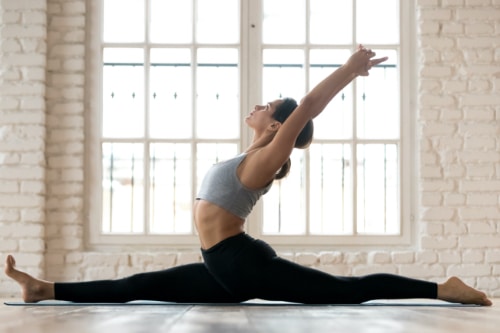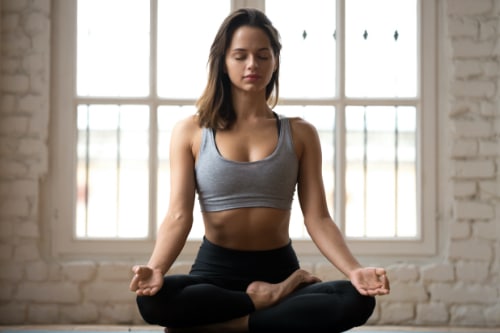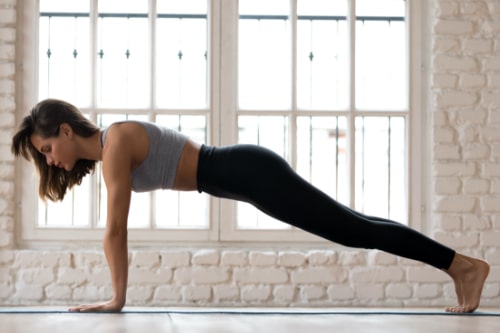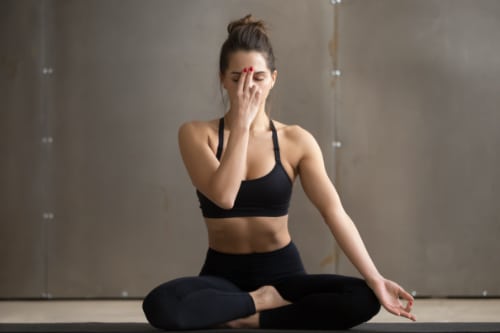The word “yoga” means “union”. Yoga aligns the mind with the body. The benefits of yoga are both physical and emotional. Yoga is a practice that has existed since ancient times.
The relevance of yoga has never got lost. Yoga helps achieve perfect mind and body alignment. Therefore, even today, yoga is necessary for healthy and wholesome living. Different types of yoga asanas focus on a common goal: overall well-being and physical health.
You can practice types of yoga in the comfort of your home and reap all its benefits. The best part about yoga is that you need just a mat and half an hour every day to get started on this path.
These days, yoga forms have become a part of our lives. Yoga is a therapeutic tool to treat physical and mental problems. Therefore, it is not right to assume that yoga is for a particular religion or community.
If you search online, you can find different types of yoga that target specific health issues. For example, therapy yoga includes yoga for back pain, yoga to reduce belly fat, yoga asana for weight loss, and even weight gain. These are a set of physical postures and breathing exercises that target the problem holistically and eradicate the issues.
Benefits of Yoga
Yoga, unlike other forms of exercise, is a way of life. Terms like yoga glow, yoga abs, yogic calmness have become popular over the years.
Someone who practices yoga over time sees a vast difference in her body and how she feels. Some of the key benefits of yoga are:
- A sustained practise results in weight loss
- Improved blood circulation, which improves skin quality and texture
- Delays overall ageing and is therapeutic by nature
- Improves physical stamina
- Good for gut health and improved digestion
- Enhances fertility and reproductive health
- Improves sleep cycle
- It makes you calm and happy
- Improves concentration
- Reduces stress
- Improves immunity
Research shows the therapeutic goodness of yoga. Practising yoga makes one fitter when compared to people who don’t do yoga.
Different Types of Yoga
Hatha Yoga
The Sanskrit word Hatha means “force.” Therefore, hatha yoga restores the balance of the body. This type of yoga works on the harmony between the chakras and energy points. The chakras are vortexes of energy or the points in our body where the energy lies concentrated. They are present in seven different locations in the body and connect to specific organs and glands.
Hatha yoga comprises many physical postures and positions that balance the body and mind. Different types of yoga by various schools and teachers have certain fundamental commonalities.
Research shows that Hatha yoga helps us destress, stay physically fit and agile, and make us look younger. In addition, Hatha yoga purifies and heals our system. Also, sustained practice leads to weight loss and toned muscles.
The different types of yoga forms borne out of hatha yoga are:
Ashtanga Yoga
Ashtanga yoga is a direct offshoot of sage Patanjali’s Yoga Sutras. Famous as the yoga form for weight loss, the ashtanga word is a derivative of the word eight in Sanskrit.
Ashtanga yoga has eight pillars: Principles, personal discipline, asana and postures, pranayama, withdrawal, concentration, meditation and salvation.
Some of the common different types of asanas practiced in ashtanga yoga are:
- Padmasana
- Simhasan
- The Butterfly
- Kapalbhati pranayama
- Anulom vilom pranayama
- Surya bhedi pranayama
- Chandra bhedi pranayama
If you are looking for yoga for anxiety and stress relief, upper back pain, lower back pain, or fat loss, ashtanga would be the best for you.
Vinyasa Yoga
This form of yoga is also called “flow” yoga. The word “Vinyasa” has two parts, with Vi meaning variation and Nyasa meaning within prescribed limits.
Vinyasa yoga incorporates movement and breathing techniques. It creates a flow of postures with controlled breathing replicating the flow of life. For example, Vinyasa yogis initiate the flow with a child’s pose and terminate the flow with the death pose (the savasana). The transitions into each posture reflect the movement through life. Meditation is a part of advanced vinyasa yoga practices, making the form more mindful.
For a beginner in vinyasa yoga, the ideal sequence would be:
- Plank pose (Kumbhakasana)
- Knees-Chest-Chin Pose (Ashtanga Namaskara)
- Cobra pose (Bhujangasana)
- Downward-Facing Dog pose (Adho Mukha Svanasana)
Vinyasa yoga is a good choice for the ones who like high-intensity exercises. In addition, Vinyasa yoga is ideal for anxiety, depression, blood pressure and sleep.
Kundalini Yoga
Also known as the “yoga of awareness,” kundalini yoga includes repetitive poses. Kundalini yoga awakens the latent kundalini Shakti. This spiritual energy resides at the base of the spine. Yogis believe that Kundalini Shakti is like a coiled snake, unaroused at the base of the spine. Therefore, the active energy moves up the spine and contributes to your spiritual well-being. Kundalini yoga is also suitable for stress, anxiety, depression and better cognitive function.
Movements begin with a chant, followed by pranayama, the act of controlled and precise breathing. Then comes kriya, a set of postures or mudras (specific hand positioning). Then one performs pranayama, chanting, and meditation.
Jal neti kriya is a cleansing technique that helps remove mucus and other blockages from the nasal passage.
Iyengar Yoga
This type of yoga is quite similar to vinyasa yoga. It gets its name from B.K.S. Iyengar, one of the foremost yoga teachers in the world. Iyengar yoga is different from other types of yoga. It focuses primarily on posture, body alignment and opening of the body. It also uses props such as yoga blocks and belts to perfect poses.
Benefits
- Increase Flexibility
- Toned muscles
- A calmer mind
- Pain relief
- Improved posture and alignment
- Protection from disease
- Improved breathing
- Strengthen the muscles
A study shows that Iyengar yoga has effectively cured musculoskeletal disorders. In this condition, one faces severe back and neck pain. In addition, it has shown visible results in treating disabilities of the spine. The development of strength, mobility and stability is progressive. It also helps in curing gynaecological and gastroenterological diseases.
Aerial Yoga
It is suitable not only for advanced people but also for beginners. It helps to build toned and lean muscles. As opposed to traditional yoga, aerial yoga also incorporates other exercises-all while defying gravity. It has the goodness of yoga and cardio exercises like swimming or running.
In this particular yoga, a rope suspends our body in the air, and poses are introduced hereafter.
Benefits
- Burns body fat
- It improves flexibility
- Cures breathing difficulties
- Provides relief from stress
- Increases core strength
- Improves posture
Four Main Paths of Yoga
Karma Yoga
Karma yoga is one’s path of devotion to selfless work. In other words, it is a yoga of action. It signifies that one has to devote time, energy, and effort to any task. There should not be any expectation of a reward or approval. It is considered a humbling practice as one works not for the ego but the greater good.
Jnana Yoga
Jnana yoga is the yoga of intellectual knowledge and practical wisdom. This form is all about self-realisation through meditative awareness. One experiences knowledge and develops intuitive understanding. One learns to separate the ego from the true Self.
Jnana yoga comprises three main stages:
- Sravana (hearing or exposing oneself to knowledge),
- Manana (thinking and revisiting the wisdom for enhanced understanding),
- Nididhyasana (meditation).
Jnana yoga may not be physically challenging, but it is one of the most challenging forms of yoga to practice, as it requires an open mind.
Raja Yoga
Raja Yoga means king in Sanskrit. Raja Yoga is also known as ‘classical yoga’, ‘king of yogis’ or ‘yoga of the mind’. It is also called ashtanga yoga.
The word ashtanga alludes to the number eight, and ashtanga yoga also comprises of eight steps:
- Yama (Principles)
- Niyama (Personal Discipline)
- Asana (Positions and Postures)
- Pranayama (Breathing Practices)
- Pratyahara (Withdrawal)
- Dharana (Concentration)
- Dhyan (Meditation)
- Samadhi (Salvation)
Asanas can be practised and polished over time to achieve perfection. For example, some of the common asanas practised in ashtanga yoga are Padmasana (the lotus pose), Simhasana (the lion pose), Bhadrasana (the butterfly pose, etc.).
Many breathing exercises or pranayamas, like Kapalbhati, Anulom Vilom, Surya Bhedi, Chandra Bhedi, etc., make it suitable to combat day to day stress. Raja yoga is perfect for you if you want yoga for anxiety, stress relief, or back pain.
Bhakti Yoga
Bhakti comes from bhaj, which means to worship or love God. Some people consider bhakti-yoga a way to liberate themselves from the eternal birth and death cycle. Treading this spiritual path helps unite one’s soul or ‘atman’ with Brahman or ‘true reality.’
Depending on the type of Bhakti you choose to follow, you identify as a particular type of devotee or bhakt.
- Artha – distressed one
- Artharthi – one who wants materialistic wealth
- Jijnasu – the curious one
- Jnani – the self-aware one
Different Formats of Yoga Practices
Yoga in the modern world has evolved and branched out into specific practices.
Face yoga
Involves massages and exercises that work the muscles of your face to soften and relax them to shake off stress, tension, and worry. This form of yoga has become popular in the last few years. The followers think that this form of yoga reverses ageing and makes you look younger by a decade.
Yin Yoga
Yin yoga is a mix of martial arts and yoga. This form increases blood circulation in the joints and improves flexibility and muscle tone. Postures last for at least a minute, and through practice, one can hold the same pose for five minutes or more. Yin yoga also makes resourceful use of props like blocks and blankets. It hence is known to be practised post-workout due to its ability to relax the body’s joints.
Yang Yoga
Yang yoga is relatively less experimental and mixes Hatha, Vinyasa, and Ashtanga. This form is more energetic than Yin Yoga. It focuses on cultivating vigour, endurance, easing out the tension in the body, and building muscle mass.
Power Yoga
Power yoga derives its roots from ashtanga yoga. One needs to perform Yoga postures at a much quicker and more active pace. It works to tone the muscles and also enhances flexibility.
Restorative Yoga
Restorative yoga aims to relax completely into the various poses. This form of yoga uses props for body support. Guided meditation is an integral part of restorative yoga. The main focus of restorative yoga lies in relaxing the nervous system. A great form to actively destress and calm those anxious nerves. The idea is to hold poses for a few minutes.
Prenatal Yoga
Prenatal yoga aims to reduce the discomfort and pains associated with pregnancy. Prenatal yoga teaches some handy breathing exercises that can be pretty helpful during labour. Some techniques taught in prenatal yoga can also be part of postnatal yoga. This form helps new mothers to lose some weight gained during pregnancy.
Benefits of Yoga During Pregnancy
- Endurance of pelvic muscles needed for childbirth
- Decreased lower back pain, nausea, and headaches
- Controls shortness of breath
- Improves sleep quality
- Relieves overall stress
There are different types of yoga for everyone. Find out the yoga technique that works best for your needs with the guidance of a certified yoga trainer. Remember that one cannot feel the benefits of yoga in a short time frame. It is a long-term commitment. Once you get involved and regular, you will never want to give up on yoga.
Frequently Asked Questions (FAQs)
Q. What are the four main paths of yoga?
A. The four main types of yoga are Karma Yoga (selfless service), Bhakti Yoga (devotion), Raja Yoga(meditation), Jnana Yoga (intellect).
Q. What are the eight styles of yoga?
A. Eight popular styles of yoga are Ashtanga yoga, Hatha yoga, Hot yoga, Iyengar yoga, Kundalini yoga, Power yoga, Restorative yoga, Vinyasa yoga.
Q. What are the five major types of yoga?
A. The significant types of yoga are Ashtanga, Hatha Yoga, Vinyasa Yoga, Kundalini Yoga, Anusara Yoga
Q. What is the most popular yoga?
A. Hatha yoga is the most popular yoga. It is a series of gentle sequences coupled with meditation. This type of yoga is ideal for people who decide to do yoga for the first time, as its postures are comparatively easy.
Q. What is the hardest type of yoga?
A. For any form of yoga to be perfected requires years of practice. For example, no posture is perfect on day one. Similarly, it takes years to get the mind in control. As a result, some may find concentrating hard and others yoga postures tough.
Q.Which type of yoga is best for weight loss?
A. All yoga forms can ensure weight loss. Powerful postures give the benefits of a full-body workout. It burns calories through rapid and continuous movement.
Q.What kind of yoga is mostly stretching?
A. Restorative yoga is a meditative style. It includes stretching by holding poses for up to several minutes.
Q. What are the five benefits of yoga?
A. It improves metabolism, helps relieve stress, aids in weight loss, reduces lower back pain and improves sleep quality.
Q. What are the disadvantages of yoga?
A. There are no disadvantages if practised under the supervision of a trained teacher.
Q. How quickly does yoga change your body?
A. The period can vary from person to person. Yoga Takes time when compared to a heavy workout. It takes about 6-12 weeks to show results when done consistently.
Q. Is 25 minutes of yoga a day enough?
A. In general, a minimum of 20 minutes of yoga a day is sufficient to see visible results. Breaking down the practice to sun salutation, standing poses, lying down poses and focusing on different body parts on different days make short practice effective.
Q. What age group is yoga most popular?
A. Yoga is effective for all age groups. But, unfortunately, many teenagers stay away from it due to its meditative quality. However, things are now changing due to their therapeutic qualities.
Q. What is the best time to do yoga?
A. Yoga is usually practised at dawn or dusk to reap maximum benefits.





